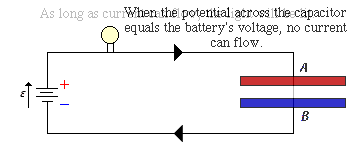We defined the electric potential or the potential difference as the work done on a unit of positive charge by an external agent. Inside a battery, "the external agent" is the chemical reaction which moves a positive charge from the lower terminal to the upper terminal, thus producing a potential difference. The potential difference produced inside the battery is called the electromotive force (emf) and usually indicated by the symbol e (in volts) or the abbreviation EMF. The direction of the electromotive force is shown by the arrow in the animation below. Note that the arrow also indicates the direction of the electric field inside the battery.
Since the capacitor plates are initially carry no charges and at zero potential, the electric field set up by the battery moves positive charge carriers from the positive terminal of the battery to the upper capacitor plate (A). The same electric field moves positive charges away from the lower capacitor plate (B) to the negative terminal of the battery. Thus, the plate A is getting positively charged and the plate B is negatively charged. A potential difference is being produced across the capacitor plates. This charging process stops (and current ceases to flow) when the potential difference across the capacitor plates becomes equal to the EMF of the battery.

Capacitors are used in all kinds of circuits, from radios to remote controls to computers. Large capacitors can be used to store larger amounts of charge, and can hold that charge for weeks after they are removed from a circuit.